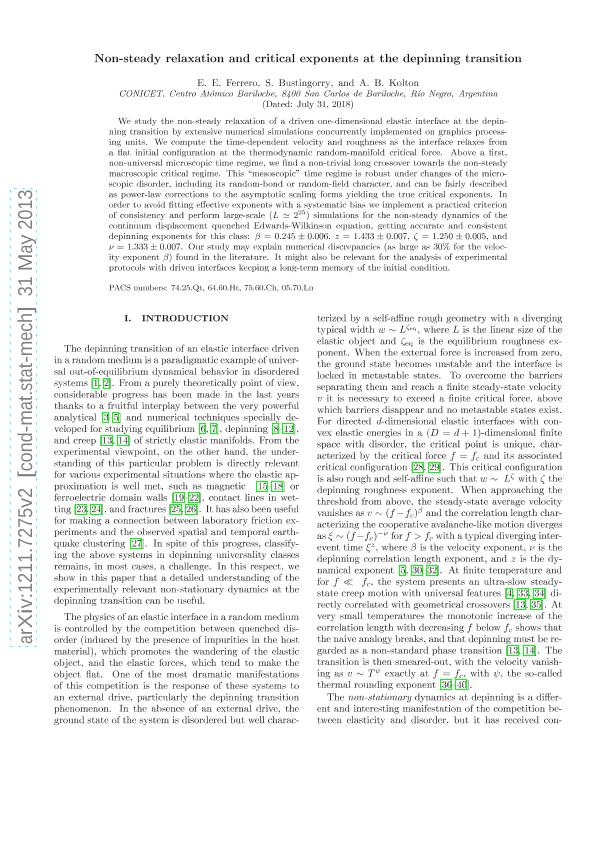Mostrar el registro sencillo del ítem
dc.contributor.author
Ferrero, Ezequiel E.

dc.contributor.author
Bustingorry, Sebastián

dc.contributor.author
Kolton, Alejandro Benedykt

dc.date.available
2017-08-04T21:42:11Z
dc.date.issued
2013-03-11
dc.identifier.citation
Ferrero, Ezequiel E.; Bustingorry, Sebastián; Kolton, Alejandro Benedykt; Nonsteady relaxation and critical exponents at the depinning transition; American Physical Society; Physical Review E: Statistical, Nonlinear and Soft Matter Physics; 87; 3; 11-3-2013; 1-14
dc.identifier.issn
1539-3755
dc.identifier.uri
http://hdl.handle.net/11336/21933
dc.description.abstract
We study the nonsteady relaxation of a driven one-dimensional elastic interface at the depinning transition by extensive numerical simulations concurrently implemented on graphics processing units. We compute the time-dependent velocity and roughness as the interface relaxes from a flat initial configuration at the thermodynamic random-manifold critical force. Above a first, nonuniversal microscopic time regime, we find a nontrivial long crossover towards the nonsteady macroscopic critical regime. This “mesoscopic” time regime is robust under changes of the microscopic disorder, including its random-bond or random-field character, and can be fairly described as power-law corrections to the asymptotic scaling forms, yielding the true critical exponents. In order to avoid fitting effective exponents with a systematic bias we implement a practical criterion of consistency and perform large-scale ( L ≃ 2 25 ) simulations for the nonsteady dynamics of the continuum displacement quenched Edwards-Wilkinson equation, getting accurate and consistent depinning exponents for this class: β = 0.245 ± 0.006 , z = 1.433 ± 0.007 , ζ = 1.250 ± 0.005 , and ν = 1.333 ± 0.007 . Our study may explain numerical discrepancies (as large as 30 % for the velocity exponent β ) found in the literature. It might also be relevant for the analysis of experimental protocols with driven interfaces keeping a long-term memory of the initial condition.
dc.format
application/pdf
dc.language.iso
eng
dc.publisher
American Physical Society

dc.rights
info:eu-repo/semantics/openAccess
dc.rights.uri
https://creativecommons.org/licenses/by-nc-sa/2.5/ar/
dc.subject
Disorder
dc.subject
Depinning
dc.subject
Short Time Dynamics
dc.subject
Critical Exponents
dc.subject.classification
Física de los Materiales Condensados

dc.subject.classification
Ciencias Físicas

dc.subject.classification
CIENCIAS NATURALES Y EXACTAS

dc.title
Nonsteady relaxation and critical exponents at the depinning transition
dc.type
info:eu-repo/semantics/article
dc.type
info:ar-repo/semantics/artículo
dc.type
info:eu-repo/semantics/publishedVersion
dc.date.updated
2017-07-24T12:50:05Z
dc.journal.volume
87
dc.journal.number
3
dc.journal.pagination
1-14
dc.journal.pais
Estados Unidos

dc.journal.ciudad
Maryland
dc.description.fil
Fil: Ferrero, Ezequiel E.. Consejo Nacional de Investigaciones Científicas y Técnicas. Centro Científico Tecnológico Conicet - Patagonia Norte; Argentina. Comisión Nacional de Energía Atómica. Gerencia del Area de Investigación y Aplicaciones No Nucleares. Gerencia de Física (Centro Atómico Bariloche); Argentina
dc.description.fil
Fil: Bustingorry, Sebastián. Consejo Nacional de Investigaciones Científicas y Técnicas. Centro Científico Tecnológico Conicet - Patagonia Norte; Argentina. Comisión Nacional de Energía Atómica. Gerencia del Area de Investigación y Aplicaciones No Nucleares. Gerencia de Física (Centro Atómico Bariloche); Argentina
dc.description.fil
Fil: Kolton, Alejandro Benedykt. Consejo Nacional de Investigaciones Científicas y Técnicas. Centro Científico Tecnológico Conicet - Patagonia Norte; Argentina. Comisión Nacional de Energía Atómica. Gerencia del Area de Investigación y Aplicaciones No Nucleares. Gerencia de Física (Centro Atómico Bariloche); Argentina
dc.journal.title
Physical Review E: Statistical, Nonlinear and Soft Matter Physics

dc.relation.alternativeid
info:eu-repo/semantics/altIdentifier/doi/http://dx.doi.org/10.1103/PhysRevE.87.032122
dc.relation.alternativeid
info:eu-repo/semantics/altIdentifier/url/https://journals.aps.org/pre/abstract/10.1103/PhysRevE.87.032122
dc.relation.alternativeid
info:eu-repo/semantics/altIdentifier/url/https://arxiv.org/abs/1211.7275
Archivos asociados
